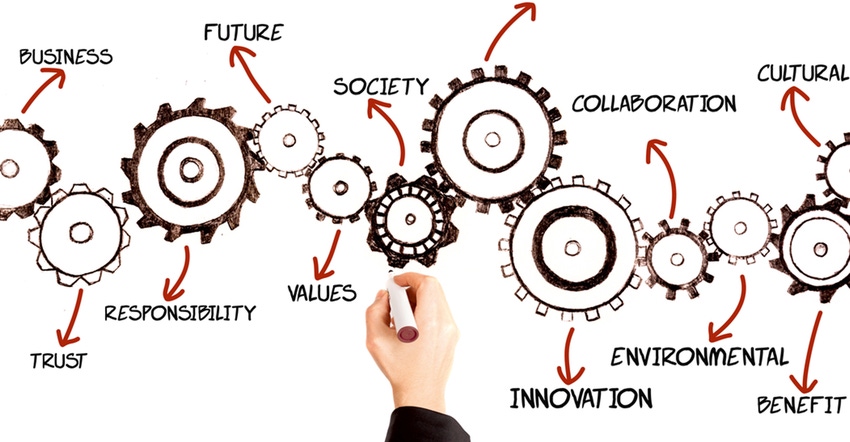
‘Tis the season of falling leaves, pumpkin spice lattes and sustainability reporting – the time of year when companies examine and share their Environmental, Social and Governance (ESG) progress. As the topic of sustainability grows in importance in our industry and beyond, a growing number of both publicly- and privately-held waste and recycling companies are publishing sustainability reports – some for the first time in 2020.
For publicly-held companies this annual ritual affords the opportunity to communicate our sustainability goals, and our progress toward achieving these goals. Perhaps it shouldn’t be surprising that the sustainability reports that have been released over the past several months have a distinctly different look and feel. In the past, most content focused on environmental metrics and progress from the previous years’ activities, with employee and community engagement programs, as well. Conversely, almost every report recently published emphasizes that company’s response to issues that reach far beyond environmental metrics.
It is impossible to ignore the multiple crises of 2020, and their impacts on our industry, as well as our reaction to the events of the year. And it is perfectly appropriate to highlight our response to these events in our sustainability reports.
As the result of this moment in time, many successful companies have catapulted their employee and community programs to the same level as their environmental programs. In doing so, these companies have highlighted their corporate leadership strength in the midst of a global crisis. They have exhibited their ability to lead, and to care for their employees and communities, while maintaining their commitment to the environment.
Simply put, this is what sustainability is. In 2020, companies are working to meeting sustainability head on, and are using their sustainability reports to communicate their understanding of the complex world in which we live, and their ability to respond to it. The impact of COVID-19 and the social justice issues that surfaced in 2020, combined with a record number of hurricanes and fires have elevated these reports beyond simple environmental reporting and squarely into the realm of full ESG Sustainability Reporting.
Although the catalyst for this evolution has not been something we ever would have wished for, the result has been a transition that needed to happen. In our world today, we can’t compartmentalize the environment and people. Our stakeholders – employees, customers, communities, regulators and investors - expect us to be taking action to mitigate climate change. These same stakeholders also see the linkages between well run companies who take care of their employees, their communities and the environment regardless of the circumstance. While COVID-19 and sustainability are distinctly different issues, both required companies to address an array of sometimes complicated employee and customer issues beyond environmental performance.
But the story is deeper and older than 2020. Companies don’t become resilient overnight. The same companies surviving through COVID-19 are those that that already had strong leadership teams and effective crisis management plans in place. Although COVID required a much different response than a hurricane or fire, many of the same principles apply, and the same processes for action that was put quickly in motion.
The Purpose of the Sustainability Report
We recently had an internal dialogue about the purpose of the sustainability report – a good conversation to have periodically to ensure alignment and adjust as needed to changing dynamics. Ultimately, we agreed that sustainability reports are intended to serve multiple purposes:
Reporting on goals. An annual report is a way to publicly state (and restate) sustainability goals, and to report on a company’s progress toward achieving them. This annual reporting is critical to ensure transparency, and evidence that we are doing what we say we will do. It holds us accountable and to high standards.
Providing data and stories to describe how we will achieve our goals. Through key performance indicators and descriptions of programs, we can describe how we are going about achieving our goals. The report also allows us to communicate specific information about our company that our employees, customers, communities, regulators and shareholders request of us.
Communicating the commitments and values of our organization. When written well, a sustainability report can convey the essence of an organization, and its commitment to all of its stakeholders. Sustainability reports reflect an organization’s culture, connect employees and other stakeholders in a shared sense of purpose, and reaffirm a company’s values and vision.
If we agree with these points as the purpose of a sustainability report, it follows that sustainability reports are the written representation of a company’s character, aspirations and commitment to serving stakeholders with integrity. The report is a way to communicate policies that support employees and foster a safe work environment. It describes how we work within our local communities, and how we provide transparent information to stakeholders about our people, programs and operations. We feature these examples proudly as part of our commitment to sustainability, and we are forthright in acknowledging areas in need of improvement.
In just one year, the institution of sustainability reporting has moved forward dramatically - incorporating a broad range of ESG issues that makes up true, balanced sustainability. By including descriptions of goals and activities supporting our employees and communities, alongside our companies’ progress to achieving environmental goals, we are moving to a more balanced sustainability reporting within our industry.
2020 has been a year that we all look forward to putting behind us. At the same time, we have gained hard-won experience and lessons that we will bring with us into 2021 and beyond. Transparent and comprehensive sustainability reporting is at the top of that list.
About the Author(s)
You May Also Like


